Here are the main differences between the Gibson Les Paul Standard vs Gibson SG Standard electric guitars, including tone, weight, build, and how they feel to play
You’ve made the decision you want one (or both) of two of the most iconic guitars in musical history—the Gibson Les Paul™ and the Gibson SG™. But first, you want to know what the difference is between them. Well, you’re in the right place because, in this Gibson Gazette article, I’ll explain the difference between the two models to help you choose between the Gibson SG and the Gibson Les Paul.
Quick caveat: If you’re thinking of getting your first Gibson electric or upgrading to something iconic, this is one of the most important decisions you’ll make. However, there’s no right or wrong answer at all. Each guitar, whether it’s a Gibson Les Paul or Gibson SG, or even something different like a Gibson Firebird, for example, has its own unique feature set. I have all three models and love them for different reasons, so before you start any research or try to figure out the differences between the Gibson Les Paul and Gibson SG, try to play as many as you can first because all that matters is that you find the best guitar for you.
Check out the Gibson Gear Guide video below, in which we compare all the different Gibson electric guitar shapes.
In this article, I’ll break down the differences between the Gibson Les Paul vs Gibson SG so you can decide which guitar fits your playing style, tone preferences, and performance needs. Both the Les Paul Standard and SG Standard are legendary designs with decades of history behind them. From Slash with his customary Les Paul slung low to Angus Young kicking his way across the stage with his SG on his hip, these guitars have powered some of the biggest sounds in rock, hard rock, blues, and beyond. But while the two models share certain pickup and control configurations, and both have serious kudos, they feel and sound very different. Let’s get into what sets them apart.
Quick note: the guitars I’m using for comparison here are made to classic specifications unless otherwise stated. I’m not using Gibson Custom Select, Mod Collection™ guitars, or other modern variants—I’m referring to traditionally configured, twin-humbucker models such as the Gibson Les Paul Standard 50s and the Gibson SG Standard. Those will give us the fairest comparison.
What are the main differences between the Gibson Les Paul Standard and the Gibson SG Standard?
The main differences between the Gibson Les Paul Standard and the Gibson SG Standard are body weight, body design, and upper fret access. The Les Paul tends to be heavier, with a thick maple-capped mahogany body and a single cutaway. This construction is thought to be the ultimate recipe for sustain. The SG is thinner and lighter, with a contoured double-cutaway design with extended upper fret access and a sharper, more aggressive tone.
Each model suits different playing styles, with the Les Paul known primarily as a blues and rock guitar and the SG leaning more towards hard rock, punk, and heavy metal. However, both can do any style of music, from indie jangle (just ask Johnny Marr) to jazz. Let’s expand a bit…
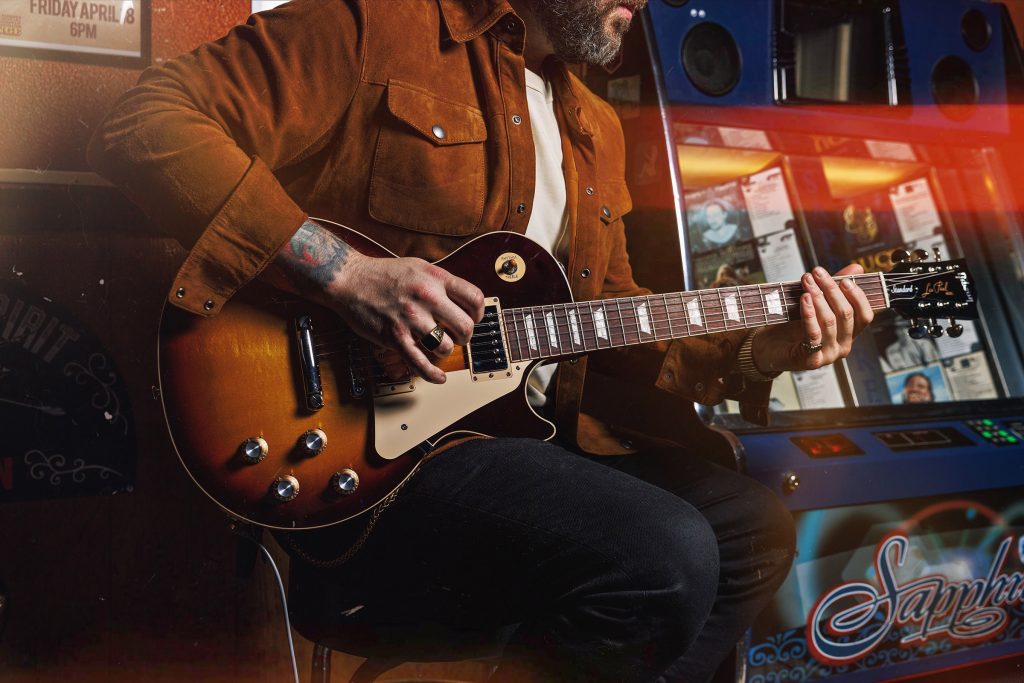
Pictured: Gibson Les Paul Standard 60s Plain Top
Body design and weight differences between the Gibson SG and Les Paul Standard
The Les Paul Standard has a thick, solid mahogany body with a carved maple cap that usually has a total depth of around 45 mm at the edges. These guitars are typically in the 8.5 lb-9.5 lb region, and you feel the weight both physically and sonically. It’s part of the appeal and mythos of the Les Paul allure—just think about Paul Kossoff wringing every drop out of the passionate guitar solos that were his calling card or Gary Moore letting single notes sustain for days. In its original, non-weight-relieved form, the density of a Les Paul Standard delivers sustain like no other, combined with a rich midrange, low-end thump, and plenty of aggression.
The Gibson SG has a much thinner mahogany body (approximately 33 mm) with deep cutaways, beveled edges, and no maple cap. It’s significantly lighter and more contoured than the average Les Paul Standard, and many players find this more comfortable, especially those with a smaller frame or those who play standing for long periods of time. The SG balances differently on a strap, but any neck dive can usually be combated with a wide strap. The SG’s thinner all-mahogany body and different pickup locations relative to the 12th fret and bridge usually deliver a more focused tone than a Les Paul Standard, with less sustain but plenty of bite—ideal for hard rock riffs and soaring slide parts. Just ask Angus Young or Derek Trucks.
Neck joint and upper-fret access differences between the Gibson SG and Les Paul Standard
Les Paul: The set neck joins the body at the 16th fret. You can reach the upper frets, but it can be a bit of a stretch for those with smaller hands. As the many blazing soloists who have used Les Pauls over the decades will attest, it’s manageable but not effortless. Most would agree the juice is worth the squeeze.
SG: Depending on the model year, the neck joins the body at either the 19th or 22nd fret, so you get unobstructed access to the full range of the fretboard. If you play a lot of bottleneck slide or lead and melody lines in higher registers, you’ll love this.
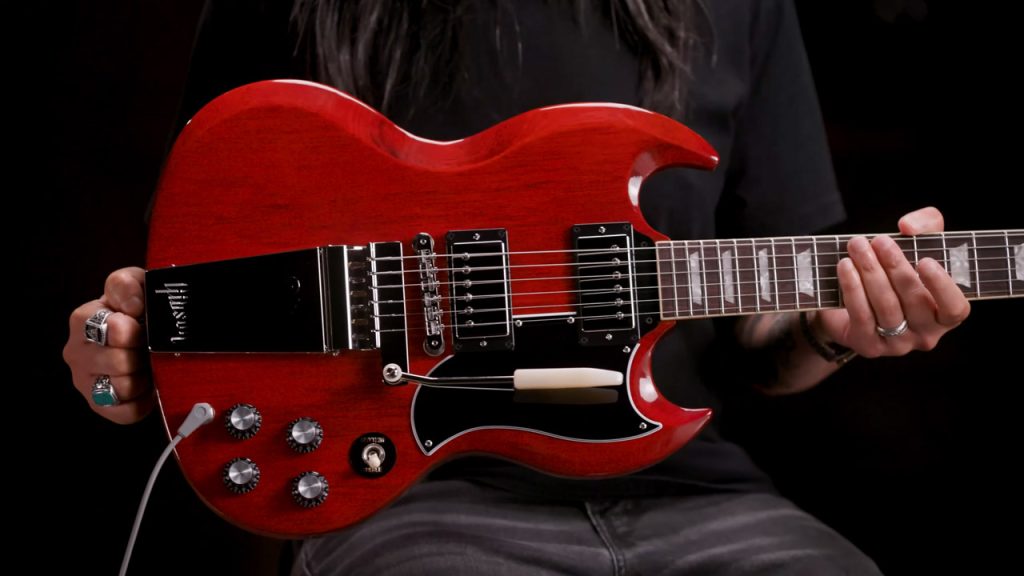
Pictured: Gibson SG Standard ’61 Maestro Vibrola
Tone and sound profile differences between the Gibson SG and Les Paul Standard
I’m going to caveat this with “it depends on the pickups.” Pickup specifications play a huge role in the tone of any electric guitar, and not all humbuckers are created equal. Here, I’ll focus mainly on how the body shape and construction impact the tone.
Les Paul: Warm, fat, and full-bodied. The maple cap adds brightness and articulation, but overall, you get a smooth, creamy midrange and loads of low-end punch, along with sustain for days. Great for blues, rock, hard rock, and even jazz or metal. It’s also important to note that a Les Paul Standard with original Patent Applied For humbuckers or modern clones, such as those from the Gibson Pickup Shop, typically has an extended upper-harmonic range that facilitates some pretty heavenly highs. You can even play country on them!
SG: Typically more focused and aggressive. A little brighter, brasher, and barkier. Think of Angus Young’s tone compared to Paul Kossoff or Gary Moore. There is less full bass response than a Les Paul Standard, but the SG cuts through superbly in a mix. Think of it as leaner and meaner, brilliant for high-energy rock, punk, or anything where you need to poke through a wall of sound. It’s also especially well-suited to slide.
Aesthetic and vibe differences between the Gibson Les Paul Standard and SG
With the caveat that both of these guitars have been used pretty interchangeably by top players in almost every genre, the Les Paul Standard’s flametop and classic curves tend to offer a more traditional look that suggests some degree of lead guitar prowess. Think Slash, Page, and Bonamassa—guitar heroes with big tone and big presence.
In comparison, the SG is leaner and edgier and lends itself a little more comfortably to alternative rock, indie, and punk. Think Carrie Brownstein and Ian MacKaye, in addition to Angus Young, Tony Iommi, and Frank Zappa. Even though it gets a seat at rock’s top table, the SG’s devil horns hint at the kind of mischievous attitude that might get it thrown out of the afterparty.
In a nutshell, when it comes to a decision between the Gibson Les Paul vs Gibson SG on “vibe” alone:
- Les Paul Standard: Substantial, warm, sustain-rich, classic rock feel
- SG Standard: Lightweight, aggressive, midrange-focused, easy playability
The Bottom line? You really can’t go wrong either way, and the tonal differences aren’t massive. Some players swear by the Les Paul Standard’s tonal girth and sustain. Others wouldn’t trade their SG’s upper fret access and strapped-on comfort for anything. I have both guitars and love the Les Paul for its longer sustain, but it’s not like the SG is all about attack—it still offers more sustain than a bolt-on electric guitar design.
Gibson Les Paul history, construction, tonewoods, and electronics
The Gibson Les Paul Model first burst (no pun intended) onto the music scene in 1952 after Gibson approached musician, inventor, and studio pioneer Lester William Polsfuss (aka Les Paul) about a collaboration. Les had been tinkering with solidbody electric guitar designs for years, but this new solidbody from Gibson was something else entirely, owing a lot more to the archtop tradition than some of the other early solidbodies of the time from rival companies, which were designed to be easily assembled on a production line.
The Gibson Les Paul Model (as it was originally known) arrived with the basic architecture intact—solid single-cutaway mahogany body, maple cap, glued-in mahogany neck, rosewood fingerboard—and boasted twin P-90 pickups and a Goldtop finish. Although early Goldtops are incredible musical instruments in their own right, most guitar experts agree that the arrival of the Patent Applied For humbucking pickup in 1957 and Cherry Sunburst finish in 1958 cemented the Les Paul Standard as the most iconic and desirable electric solidbody of all time.
You can find out more about what makes the Les Paul great here, but the way the basic elements interact—warmth and midrange from the solid mahogany body, clarity and articulation from the carved maple top, sustain from the set neck—give the Les Paul Standard its signature tone before you’ve even switched on your amplifier. And when you do, the modern Gibson humbucking pickups in our Les Paul Standards do a fantastic job of delivering noise-free performance in high volume and high gain situations across all genres, right up to heavy alternative rock and metal.
What are some of the most popular current Gibson Les Paul models?
We’re adding new Gibson Les Paul models to the catalog all the time—all of them handcrafted right here in Nashville, Tennessee, and featuring nitrocellulose lacquer finishes. Bookmark the New Arrivals page on gibson.com to make sure you don’t miss out on exclusive and limited edition specifications and finishes. In the meantime, here are three of our most popular current models:
Gibson Les Paul Standard 50s
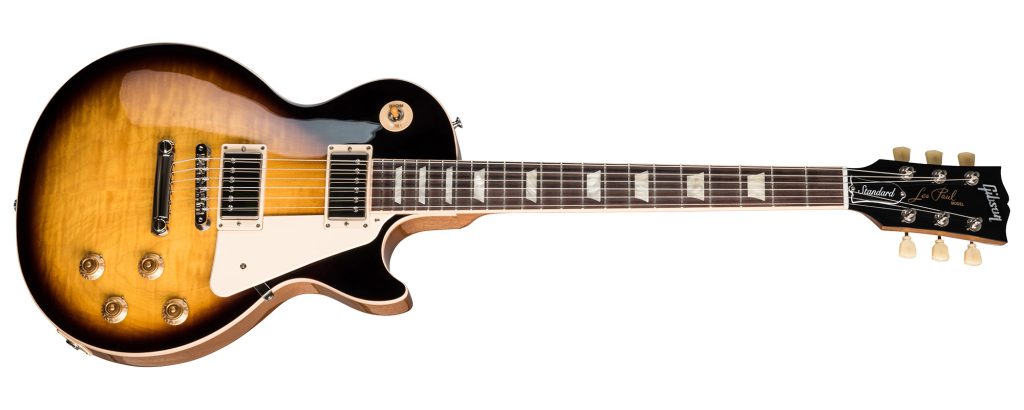
Pictured: Gibson Les Paul Standard 50s in Tobacco Burst
The Gibson Les Paul Standard 50s, pictured here in iconic Tobacco Burst, is probably the quintessential Gibson Les Paul in our Original Collection. You have a non-weight-relieved mahogany body with a carved maple cap, mahogany neck with a 50s Vintage profile, Indian rosewood fretboard with trapezoid inlays, and 22 medium jumbo frets. As for pickups, you get Burstbucker 1 and Burstbucker 2 pickups with Alnico 2 magnets that can handle anything you throw at them, and any amplifier. This is a true workhorse electronic guitar and an iconic addition to any guitar collection. The fact that you get a Gibson hardshell case to keep your guitar safe en route to rehearsals and shows is the icing on the cake.
Gibson Les Paul Studio Session

Pictured: Gibson Les Paul Studio Session in Bourbon Burst
Another very popular Les Paul model is the Les Paul Studio Session, pictured here in a Bourbon Burst finish. Hailing from our Modern collection, this guitar features an Ultra Modern weight-relieved mahogany body with an AA figured maple cap and a mahogany neck with bound ebony fretboard and SlimTaper™ profile for super-comfortable playability. Although it’s designed for the modern player, it still has vintage aesthetics reminiscent of the Les Paul Standard, like cream plastics and vintage-voiced pickups in the shape of 57 Classic and 57 Classic+ humbuckers. However, the guitar’s clever wiring features push/pull volume knobs for coil tapping and push/pull tone knobs for phase and pure bypass switching, meaning there are a lot more tones onboard. You also get a high-quality soft shell case for easy and secure transport without the weight of a hard case—ideal if you travel to shows on foot or by public transportation.
Gibson Les Paul Custom
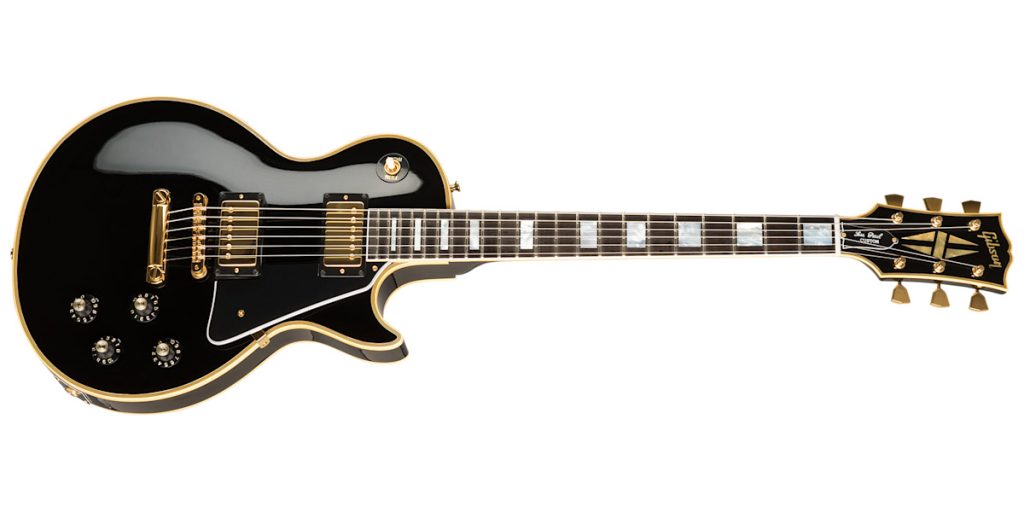
Pictured: Gibson Custom 1968 Les Paul Custom Reissue
Although this article is mainly focused on the Les Paul Standard, who doesn’t love a Custom? With an Ebony finish for that classy tuxedo look and an ebony fretboard for a little more snap than is offered by the rosewood board of a Standard, this specific model is a Gibson Custom recreation of one of the first incarnations of the Les Paul in 1968, when it returned from a production hiatus (more on that shortly).
This model features a solid one-piece mahogany back with a two-piece plain maple top, finished in gloss nitrocellulose lacquer for that deep vintage shine. There’s no weight relief here, just the full, authentic feel of a late-60s Les Paul in your hands. The multi-ply binding looks beautiful, and the 14-degree peghead angle helps reduce string tension. Designed to be the ultimate historically accurate 1968 Les Paul Custom, this reissue captures everything that made the original a legend on its return.
Gibson SG history, construction, tonewoods, and electronics
Although the sunburst Les Paul Standard is now the most iconic and desirable solidbody electric guitar in the world, its initial production run only lasted from 1958 to 1960. By late 1960, the Les Paul Standard as we know it had been superseded by a sleek new double-cutaway design, with all-mahogany construction and a much thinner and lighter body with beveled edges.
Early models were equipped with the Sideways Vibrola™ that polarizes opinion, but by the end of 1963, this was swapped out for the Maestro™ Lyre Vibrola, the neck tenon and neck depth were enlarged for greater stability, and perhaps most significantly of all, the model was rechristened the SG after the Gibson relationship with Les Paul came to an end. 1964 is regarded as a golden year for the Gibson SG—just ask George Harrison, who used his with The Beatles in 1966 on one of the greatest albums of all time, Revolver.
As previously mentioned, the SG is an all-mahogany design with a thinner body than a Les Paul Standard, which has a big impact on tone. Those double cutaways also allow for much easier upper-fret access and make slide guitar playing easier, too. Like the Les Paul Standard, SG neck profiles and nut widths vary depending on model and year, and there’s no general rule to say SGs have a slimmer neck than a Les Paul—even if the guitar’s construction makes it feel like an easier ride.
Although SGs come equipped with the typical pair of Gibson humbuckers wired to a three-way selector switch with independent volume and tone controls for each pickup, SGs tend to offer a little more upper-midrange bite than a Les Paul Standard, which is something that has proved popular over the years with guitarists from a wide range of genres, including blues-influenced players like Robby Krieger and Derek Trucks, hard rock and metal legends Tony Iommi and Angus Young, and emerging stars like Grace Bowers. For an even raunchier take on SG tone, try a P-90-equipped SG Special or Junior on for size. Just ask YUNGBLUD about the latter.
What are some of the most popular current Gibson SG models?
Gibson SG Standard
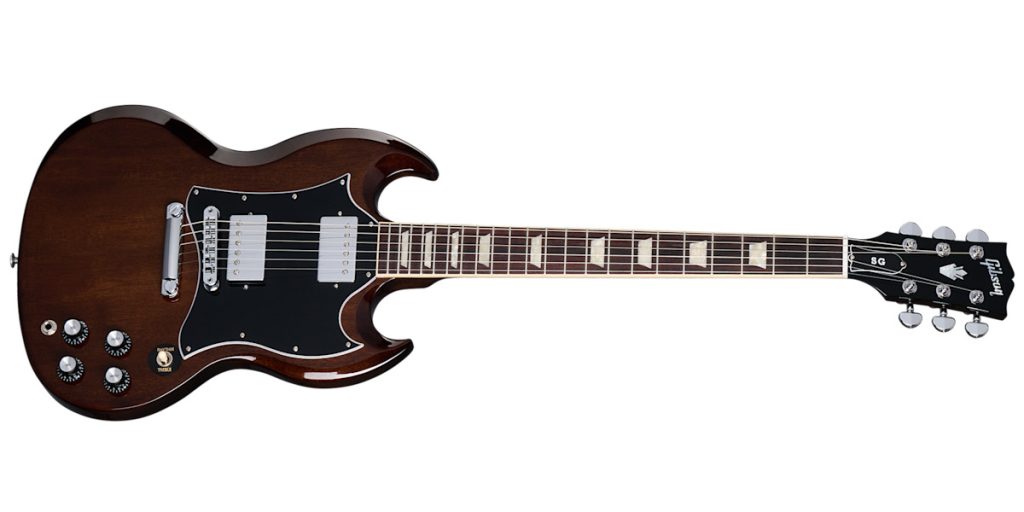
Pictured: Gibson SG Standard in Exclusive Dark Walnut
The Gibson SG Standard pictured here in Dark Walnut is the quintessential Gibson SG, just with a slightly different finish than the usual Cherry, available exclusively at Gibson.com and Gibson Garage locations. You get a mahogany body, a comfortable, Rounded mahogany neck profile, a bound rosewood fretboard which feels great beneath the fingers, and a 19th fret neck joint for easy access to the higher registers. This Gibson SG comes with 490R and 490T Alnico 2 humbucker™ pickups for a full suite of versatile sounds, and the large, late-60-style pickguard is as iconic as they come.
Gibson SG Standard ’61 Maestro Vibrola
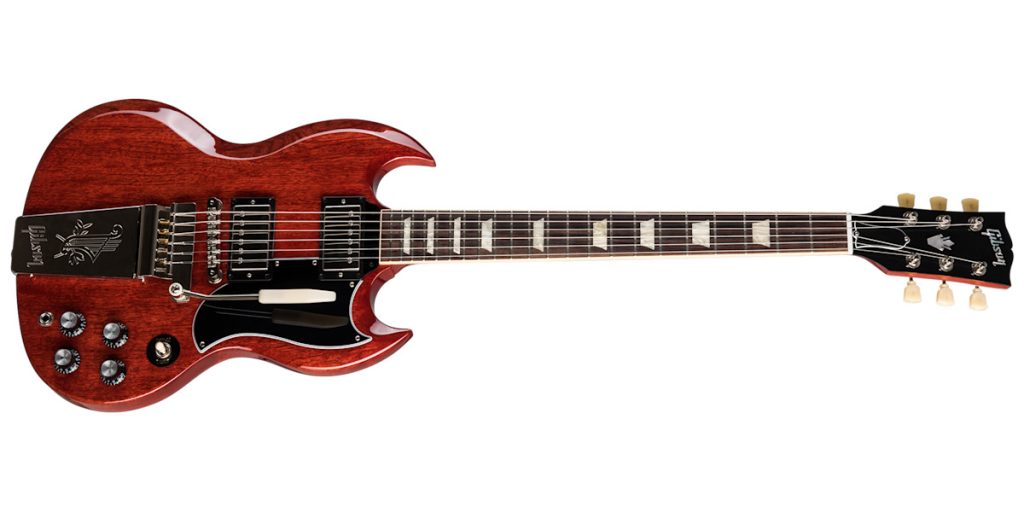
Pictured: Gibson SG Standard ’61 Maestro Vibrola in Vintage Cherry
The Gibson SG Standard ’61 Maestro Vibrola, pictured here in Vintage Cherry, faithfully recreates every aspect that made the early 60s models legendary, except this time we’ve added a Maestro Vibrola and Lyre-engraved tailpiece. It features a deeply sculpted mahogany body, a SlimTaper mahogany neck, and a bound rosewood fretboard for fast, comfortable playability. The 22nd fret neck joint and five-ply teardrop pickguard stay true to vintage specs, while 60s Burstbucker™ humbuckers provide that classic tone with plenty of that added bite I’ve been talking about. This thing is ready for solos and riffs.
Gibson Custom 1964 SG Standard Reissue With Maestro Vibrola
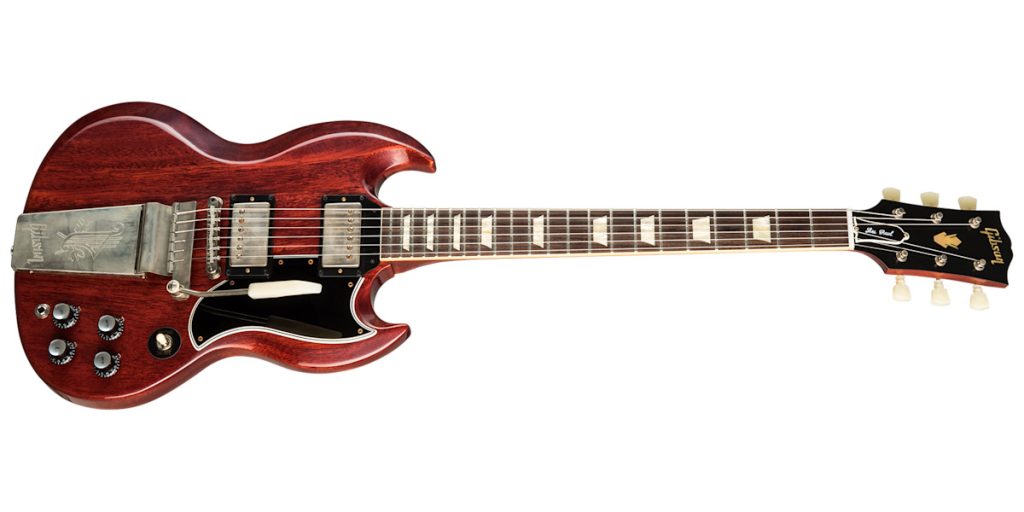
Pictured: Gibson Custom 1964 SG Standard Reissue With Maestro Vibrola in Cherry Red
Based on the 1964 SG Standard—a model year famously played by George Harrison and Eric Clapton—this SG Reissue captures a golden moment in Gibson’s history when the design, tone, and feel of the SG truly came into its own. Built by the Gibson Custom team, it features a Maestro Vibrola and all the meticulous vintage details you’d expect, right down to the red aniline dye, chemically recreated plastics, and period-correct electronics. With original construction methods and stunning accuracy throughout, this is one of the most authentic-feeling and best-playing SG reissues Gibson has ever produced. It’ll make you feel like you’ve gone back in time and grabbed one from a guitar store in the early 1960s.
Who is the Gibson Les Paul Standard for?
Again, this is highly subjective; you should play what you want to play and not let received wisdom dictate your choices, but generally, the Les Paul is for players who want guitar tone with authority and an instrument that can handle everything from mellow jazz chords to blazing rock solos. Its power, sustain, and sheer low-end depth are perfect for thick rhythm chord work, huge singing leads, and enormous riffs. I’m looking at you, Jimmy Page.
Best for:
- Rock, blues, metal, and jazz
- Studio players who want a thick but articulate tone
- Guitarists who love sustain and classic guitar hero aesthetics
- Players who don’t mind trading extra weight for tonal richness and depth
Who is the Gibson SG Standard for?
The SG is widely seen as a guitar for players who want a lighter guitar they can throw around easily on stage with fast attack, sharp mids, and easy upper-fret access. It’s great for high-energy genres and lead playing where the upper frets matter, especially if you need to stand out in a two-guitar band mix. They’re designed to rock, riff, and solo with ease, and bands as diverse as Fugazi and AC/DC have built their tone around the Gibson SG’s considerable charms.
Best for:
- Hard rock, punk, metal, blues rock, psychedelia
- Players with a smaller frame or who perform while standing for long periods
- Guitarists who need more cut and brightness in a dense multi-guitar mix
- Fans of easy-playing ergonomics and upper-fret access
Should I choose the Gibson Les Paul Standard or Gibson SG?
Choose the Les Paul if:
- You want creamy sustain and thick, classic tones
- You don’t mind the weight and increased bulk for the tonal payoff
- You love the timeless look of a Burst
Choose the SG if:
- You want speed, easier access to the upper frets, and a lighter overall build
- You perform standing during long live sets
- You love the SG’s slightly unruly and more dangerous aesthetic
Both the Gibson Les Paul Standard and Gibson SG Standard are tonal heavyweights in their own right, and there’s no right or wrong choice when it comes to the Gibson Les Paul vs Gibson SG; it just comes down to personal preference in terms of tone, aesthetics, and ergonomics.
Want more Gibson electric comparisons? Keep exploring our guitar guides on the Gibson Gazette for more breakdowns of iconic models from Gibson, Epiphone, and beyond. Let us know what you’d choose when it comes to the Gibson Les Paul vs Gibson SG!
Read the full comparison of the Epiphone SG collection and the Epiphone Les Paul collection buyer’s guide.

